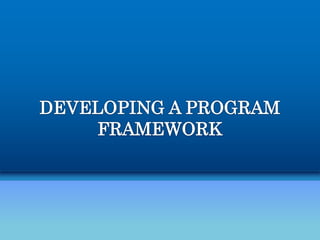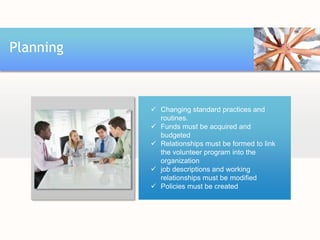Leadership and Volunteerism
- 1. Leadership and Volunteerism: Harnessing the Potential of the Youth Volunteers
- 2. Definition: Volunteerism What is Volunteerism? Volunteerism is a group of people known as VOLUNTEERS who participates in non- profitable activities and do not expect something in return. They are willing to give up their time, energy, and resources for community service and help people in need.
- 3. Volunteer Management Cycle Planning Induction & Training Recruitment Recognition Supervision & Evaluation Review
- 5. Planning Changing standard practices and routines. Funds must be acquired and budgeted Relationships must be formed to link the volunteer program into the organization job descriptions and working relationships must be modified Policies must be created
- 6. Questions to ask before conducting a needs assessment Needs Assessment Your Logo What is your organizational vision and mission? How do volunteers fit into the program’s mission, strategies and goals? What is the program’s purpose? What are you trying to accomplish in your community? How could volunteers serve more people and make a greater difference in the community? How can volunteers help meet program goals? ✓ 6 5 4 3 2 1
- 7. Catalogue of Project Database SAMPLE Build stronger neighborhoods Eradicate extreme poverty and hunger Fight HIV/AIDS, and other common illnesses Build strong schools Promote the equality between genders and the empowerment of women Guarantee the sustainability of the environment Support for people with special needs 1 2 3 4 5 6 7
- 8. Finalizing the Program Elements Create a project database that catalogues the specific leadership roles you have available. Develop a volunteer leader application to capture important information about volunteers’ interests, availability and skills. Make sure that your program has a privacy policy in effect to protect volunteers’ personal information to the same degree as that of staff members. Database Develop agreements that clearly outline the responsibilities of your organization and what is expected of the volunteer leaders. Develop corresponding agreements for volunteer leaders and each project partner. Be sure the agreements are consistent with any volunteer leader position descriptions. Agreements 1 2
- 9. Defining Meaning Roles Title Purpose/objective Location Key responsibilities Qualifications Time commitment Training/support provided Benefits Volunteer supervisor and contact information Volunteer Position Description
- 11. Ways to recruit volunteers The personal “ask” is always the most compelling! Strategically post flyers or brochures in the community. Use local media to spread the word about your volunteer opportunities. Post your volunteer opportunity on the web. Partner with volunteers from a school, community center, faith-based group or other nonprofit. Network with community groups and leaders. ✓ 6 5 4 3 2 1 Use online forums and/or blogs to spread the word. Post your leadership opportunities on the web sites of local businesses and community organizations. Develop a “perks” package, such as free meals, workouts or other goodies for outstanding leaders. Host information booths at job fairs, colleges, churches, stores, restaurants or other gathering spots. Try “snowball” tactics. 11 10 9 8 7
- 12. Selecting a volunteer leader Takes charge of a project by coordinating it and taking accountability for its successful completion. Organizes, leads and inspires a group of volunteers before, during and after the project. Represents your organization to other volunteers and to the community. Communicates the details of the project and serves as a resource for other volunteers. May initiate new projects. ✓ ✓ ✓ ✓ ✓ 1 2 3 4 5 A volunteer leader is a volunteer who:
- 14. Orienting and Training Volunteers Help volunteers better understand your organization and/or the organization where they will be serving Discuss ways volunteers can impact the community, as well as the benefits to the volunteers. Provide a document for conducting site visits/developing work plans. Highlight the basic ingredients of your civic engagement philosophy. Ensure leaders understand the importance of their roles in developing and managing projects. Ensure volunteer leaders understand the procedures and their role in reporting. 1 2 3 4 5 6
- 15. Project Checklist • Orienting volunteers • Assigning volunteers to project tasks • Managing volunteers and tasks • Facilitating service learning during project During the projectBefore the project • Evaluating impact • Overseeing project site clean up • Returning tools and materials • Following up with volunteers and project partners After the project • Making site visits and building relationships with the agency or other project partners • Identifying project tasks • Identifying service learning opportunities, such as orientation by project partners, ways for volunteers to get involved beyond the project, etc. • Developing safety and contingency plans • Creating project supply lists • Recruiting volunteers, ensuring that any specialized tasks are covered • Responding to inquiries from volunteers and project partners • Securing tools, materials, refreshments and other supplies 321
- 16. How to Create a Service Project 2 Identify what we know 3 Find out more 1 Prepare for service 7 Assess and reflect 8 Celebrate and demonstrate 6 Implement the service activity 4 Plan of Action 9 Wrap up and follow-up 5 Mobilize your community
- 17. Plan of Action 1. Determine what the group would like to do in order to bring about changeGo ahead and replace it with your own text. This is an example text. Go ahead and replace it with your own text 2. Set Goals; identify what they are going to do in order to bring about their visionGo ahead and replace it with your own text. This is an example text. Go ahead and replace it with your own text 3. Identify the steps that need to happenGo ahead and replace it with your own text. This is an example text. Go ahead and replace it with your own text 4. Determine how the group will define success for its service projectGo ahead and replace it with your own text. This is an example text. Go ahead and replace it with your own text 5. Identify learning or participant growth goals, if appropriateGo ahead and replace it with your own text. This is an example text. Go ahead and replace it with your own text
- 18. Who Will do what to achieve the goal How will it get done and by when? What help or resources will we need? How will we know if we are successful? Everyone in the group Present a proposal of our idea to the director of the youth center Work together the next two meetings (in one week) The Volunteers help to write out our ideas and proposal! We need basic supplies (paper, pencils, and markers) The youth center supports our plan Member A Interview the mayor, members of the council We will get an appointment after school (in two weeks) Interview questions, paper, pencils We will be able to arrange the meeting and have a good interview Member B Develop a short survey to ask people on the street about how they feel about trash Work together during next week’s meetings (one week to design, one week to implement it) Paper, pencils; help in designing the survey; permission from our parents People will be willing to answer our questions and will provide us with useful Information Member C Talk to the teachers and students who did the last cleanup to learn about what worked and what didn’t Ask teachers to meet with them after school; find and meet with the leaders of the school club (in one week) Paper, pencils and interview questions People will be willing to answer our questions and they will provide us with useful information Group planning table SAMPLE
- 19. Who Will do what to achieve the goal How will it get done and by when? What help or resources will we need? How will we know if we are successful? All group members Plan a community trash cleanup day with an ongoing awareness raising activity Recruit other volunteers. We will get leaders, and other community members involved (in 2 months) Volunteer and leaders; flyers, trash bags, gloves, permission from our parents 30 volunteers will come to help us, the streets will be clean and new trash cans will be in place Member A & C Get mayor and leaders to get trash cans on corners picked up regularly Initial meeting with mayor, then submit to him our findings and a request (in 2 months) Trash cans; workers and trucks to empty cans We will have trash cans that are emptied regularly Member D Ask business owners to help maintain clean streets afterwards Meet with them, show them our proposal and request their help (in two months) Proposal and the findings from our survey The business owners will commit to keeping their part of the street clean Member C Ask local newspaper and radio to come to cleanup day and ask mayor or principal to recognize the efforts Write a press release and include the information from our research (in one month) Develop the talking points for what we want people to learn about the hazards of trash and the findings of our investigation The radio and newspaper will announce and cover the event Group planning table (con’t) SAMPLE
- 20. Personal growth or life skills Leadership skills, such as the ability to make decisions, communicate effectively, be motivational and persuasive, work with diverse groups, demonstrate honesty, creativity, and patience Academic skills (school-based standards): mathematical skills, (managing finances, budgeting, presenting data) language arts, (journaling, writing persuasive pieces, reporting, speaking), social studies, history or science Work or career skills Computer literacy (using basic software, Internet search techniques); communication skills (interviewing and making presentations, writing press releases, letters to the editor, or brochures) Civic engagement skills Assessment and investigative skills, motivational skills, the ability to work effectively with teams, interviewing and analytical skills, communication and design skills, project design and implementation, proposal writing, public speaking, and monitoring and evaluation skills Technical skills Environmental competence such as investigative and observational skills; how to analyze and present information related to findings of plant, water, or environmental health; indigenous practices related to protecting and preserving their environment; newer technologies related to efficient stoves, water purification or generating energy Personality Skills Development
- 22. Coaching and Mentoring Leaders Successful coaching include the following: • A trusting, honest, respectful relationship between the coach and coachee. • Time for preparation and reflection. • Clearly defined roles, responsibilities and expectations • Effective listening skills. • Strategic questions that promote thinking. • Data collection and thoughtful feedback. Your goal is to help leaders develop their thinking and capacity. Provide clear guidelines, due dates, reminders and clarification of requirements. Know your leaders’ strengths, as well as the areas that need more development, so that you can better help them develop their skills.
- 24. Recognizing Ideas Everyday Ways Large Scale • Send thank you letters/messages via e-mail. • Send postcards or thank-you cards to volunteers after they attend a project. • Send birthday cards. • Submit pictures of volunteers for your organization’s newsletter. • Post pictures of volunteers on a bulletin board at your organization. • Give volunteers organizational goodies— hats, shirts, pins, magnets, water bottles, etc. • Invite them for coffee or lunch. • Hold annual recognition events • Recognize long-term volunteers with service awards: plaques, trophies, certificates, etc. • Put up a banner celebrating major accomplishments. • Enlist them in training staff and other volunteers. • Involve them in the annual planning process. • Organize an outing at a zoo, amusement park, sporting event, etc., where volunteers get in for free. 1 Intermediate Ways • Nominate a volunteer “Star of the Month.” • Sponsor happy hours and social events. • Recognize volunteers on local radio or television stations. • Nominate volunteers for local or national volunteerism awards. • Write articles about them in newsletters or newspapers. • Write a letter to their employers, highlighting their accomplishments • Create a photo collage or slide show of volunteer activities 2 3
- 25. Your own footer Your Logo THANK YOU!

























